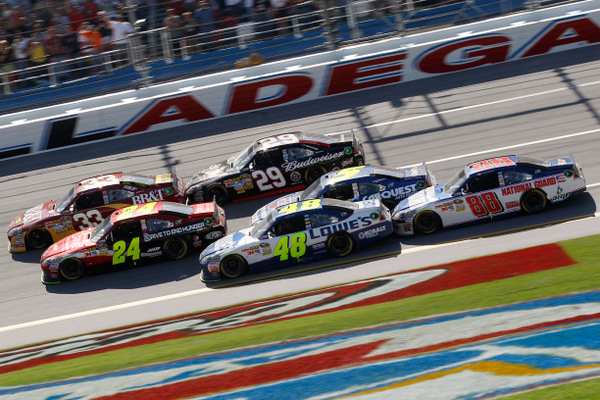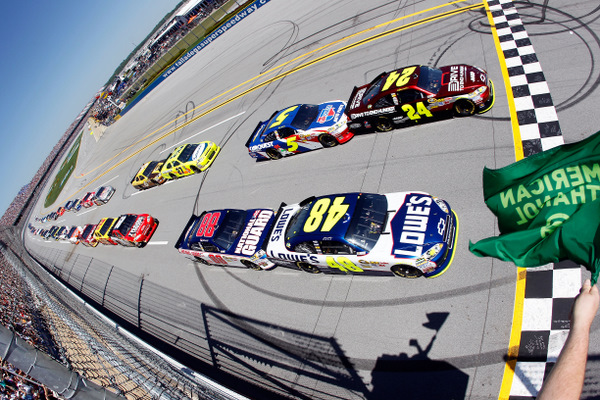Now the second-guessing? Or maybe not. And what to expect at Daytona in July?

Jimmie Johnson (48), with a good push from teammate Dale Earnhardt Jr. (88), makes his move to the inside of fellow teammates Jeff Gordon (24) and Mark Martin...who themselves are just as worried about racing rivals Clint Bowyer (33) and Kevin Harvick (29). Talladega doesn't get any better than this, with the finish line just yards ahead. (Photo: Getty Images for NASCAR)
By Mike Mulhern
mikemulhern.net
And down the stretch the leader in the two-car pack was the man with the best shot at the win; the pusher didn't seem to have much of a shot, considering that pulling out would slow the pushee, and both men would lose to rivals.
Well, drivers had game plans for how to hook up with buddies and run the race...but the end game may still be iffy.
But you certainly can't knock the finish -- if Carl Edwards and Greg Biffle had had just a couple more feet to the outside, it would have been a four-wide, two-deep photo-finish.
Eight men had a shot at the win. Jimmie Johnson -- though he did put his left-side tires on the yellow line, in a questioned pass by Mark Martin in the final yards -- got the victory, but in one of the closest finishes in this sport's history, over Clint Bowyer.
At the white, it was Jeff Gordon and Martin in command. But Johnson's late charge, with a brilliant push by teammate Dale Earnhardt Jr., proved victorious.
"Man...I saw them coming in the mirror, even through Kevin (Harvick, right behind Bowyer)," Bowyer said.
"I was like 'Gordon better block them guys, better block them guys...'
"But they were too worried about racing us...as we were them.
"Very frustrated we didn't get the win. But, man, I tell you, I hope the fans enjoyed that finish; that's what Talladega is all about."
Gordon was the man in command the last lap, with Martin pushing. Side by side against Bowyer and Harvick. Then Johnson and Earnhardt closed to their rear in the middle of the trioval, and Johnson dived low, Earnhardt following. And Edwards-Biffle took the high side.
Martin tried a bit of a block on Johnson but left just enough room for Johnson to get by.
The two-car packs set up right at the green, and drivers pretty much stuck with their planned buddies throughout the three-hour race, even with pit stops. And it wasn't the fastest car in the lead all the way, but rather pushing.
"We had the philosophy coming in 'Don't leave your wingman,'" Gordon said. "I think we learned a lot in Daytona. In Daytona we said 'Oh, let's just ride it out and see how it goes.' We didn't expect everybody to get right into twos as soon as they dropped the green flag.
"Based on that, we realized you have to have somebody you can count on, somebody that you trust -- somebody you can get on the radio and work. And who better to do that with than your teammates? In our case that was Mark Martin.
"I thought we did a really good job; we put ourselves in position to win.
"I didn't work with anybody else all day long; Mark was the only one. Sometimes I was pushing him, sometimes he was pushing me."
And Gordon-Martin could hold a five to seven second lead fairly easily.
With 25 laps to go in the 188-lapper "It comes down to a strategy race," Gordon said. "And there's more to it than you think. When you see me and Mark out there riding around, it's not as easy as you think to manage that, to figure it out. You still are having to watch your temperatures and different things.
"But then let's be honest -- Talladega has always been about a 15 to 25-lap race -- and the rest is just trying to get to the end."

Right from the Talladega green teammates were lining up in two-car packs (Photo: Getty Images for NASCAR)
Everyone -- drivers, teams, NASCAR, fans -- is still trying to figure out this two-car thing at Daytona and Talladega.
"This two-car draft is here to stay," Gordon says flatly.
"Unless they drastically change the cars....
"The restrictor plate (changing the size, to slow speeds) is not going to change that.
"It would take a whole revamping of the car to change that.
"But I kind of laugh at that -- because that's what this car was to created to do. Not necessarily two-car drafts, but to be able to get to the bumper and not spin one another out...and to have a car that's much boxier, to blow a bigger hole in the air.
"That's what's created the racing we have.
"I personally don't have a problem with it. That was pretty fun there at the end, whether I was pushing or being pushed. Those last ten to 15 laps are fun from a driver's standpoint.
"But I'm surprised there were not more incidents, with four or five to go; I was expecting it.
"It's just as easy to have a 'big one' now as ever in the closing laps.
"With the old car, and the way we were all bunched together, I thought it was absolutely ridiculous we were out there pushing and shoving and running three and four-wide at lap 40. Didn't seem to me to be very smart.
"With this two-car draft, it forces you to think a little more about how aggressive you're going to get.
"There are still some guys who want to be aggressive with it, and I think it caught them. But other guys want to be real patient with it."
Martin himself wasn't second-guessing anything: "Jeff and I were leading on the white flag lap, and, man, you couldn't ask any more than that.
"We had a crack at it...and didn't manage to pull it off."
Not everyone was quite as lucky. And Denny Hamlin, who has had a ragged spring, was drawing criticism from rivals after triggering two incidents, both ironically while buddy-pushing Ryan Newman.
Juan Pablo Montoya was a victim in the Hamlin-Newman tangles. Hamlin, Montoya said, "is always impatient here, and always causes a lot of wrecks, and he just did it again.
"This year he's been in a lot of wrecks."
Newman considered himself lucky just to finish, after the two close calls. "If there were a category for 'Saves of the day,' I think we'd be the only one who had two.
"The first was pretty big; the second one was really big.
"Just luck. You need to know what to do, but a lot of it is just luck."
© 2010-2011 www.mikemulhern.net All rights reserved.
Web site by www.webdesigncarolinas.com







Wild Race, Radically Mixed On Superdrafts
When you tie a record for lead changes that was set just last year, it's a wild race. When you win in a photo finish it's even wilder.
The superdrafts may be here to stay now, but I'm not sold that NASCAR really wants a scenario where team-racing (radio coordination of "swaps" instead of fighting for position) takes up so high a percentage of the competition, where a car pushes another car to the lead and obstinately refuses to pass the leader, and the resulting sharp increase in crashes (see Elliott "didn't I flip down this same backstretch?" Sadler versus Mike Wallace in the Aarons 312 in particular). The conventional drafting lines had great racing and allowed drivers more leeway to make moves independent of what other cars were doing.
I think NASCAR wants the superdrafts to a point - push a car into the lead then get off his bumper and pass him. I don't buy that the sport can't have the benefits of both the conventional packs and the superdrafts while limiting the liabilities of both - after all just last year at Talladega it had both.
Better Than Pack Racing
I don't like the two-car tango only because of the fact that most of what it involves is out of your hands as a driver. The trail car driver can't see where he is going, you're only as fast as your partner, etc. It's more entertaining than the choo choo train pack racing though, and though wrecks seem to be more frequent, not as many cars are involved when they happen (i.e. "the big one" isn't as big). I still wish NASCAR would figure out what to do to make these cars act independent of one another as they did in the pre-restrictor plate days. Do something with the engine, or something with the car, or maybe they can use a different fuel injection package in the future to produce lower power without having a plate. These cars are special built for Talladega and Daytona, so it's not like the teams are going to use them again for any other track. So what does it matter if something about the car is significantly different from the cars that run the tracks on the rest of the schedule? What bugs me the most about this issue is that NASCAR uses the races as their testing ground, rather than spending their own money for testing the cars and sims until they find a good solution BEFORE the cars show up at the track.
Post new comment